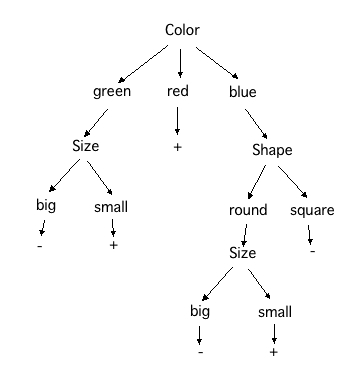


Inductive Concept Learning by Learning Decision Trees
- Goal: Build a decision tree for classifying examples as
positive or negative instances of a concept
- Supervised learning, batch processing of training
examples, using a preference bias
- A decision tree is a tree in which each non-leaf node
has associated with it an attribute (feature), each leaf node
has associated with it a classification (+ or -), and each arc
has associated with it one of the possible values of the attribute
at the node where the arc is directed from. For example,

- Preference Bias: Ockham's Razor: The simplest explanation
that is consistent with all observations is the best. Here, that means
the smallest decision tree that correctly classifies all of the
training examples is best.
- Decision Tree Construction using a Greedy Algorithm
- Original algorithm called ID3, developed by Quinlan, 1987
- Top-down construction of the decision tree by recursively
selecting the "best attribute" to use at the current node in
the tree. Once the attribute is selected for the current node,
generate children nodes, one for each possible value of the
selected attribute. Partition the examples using the possible
values of this attribute, and assign these subsets of the examples
to the appropriate child node. Repeat for each child node until
all examples associated with a node are either all positive or
all negative.



